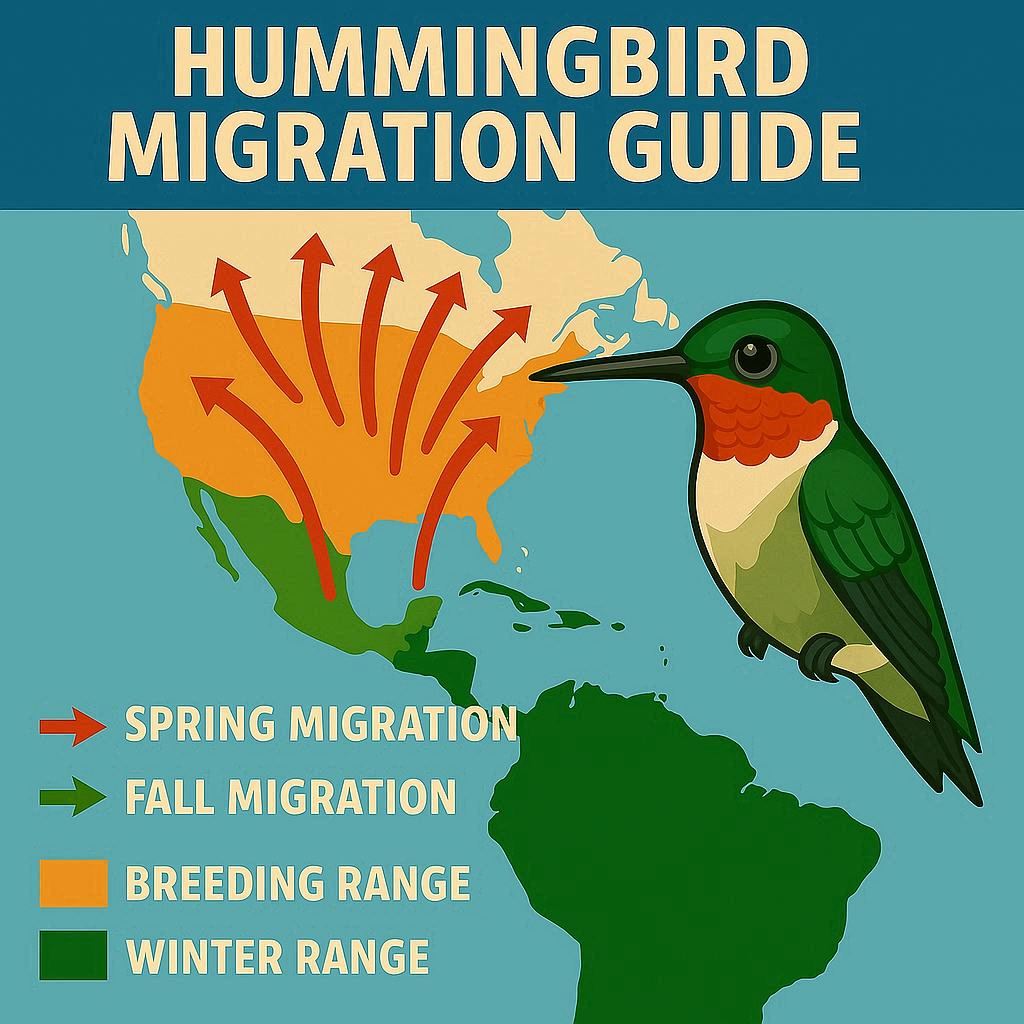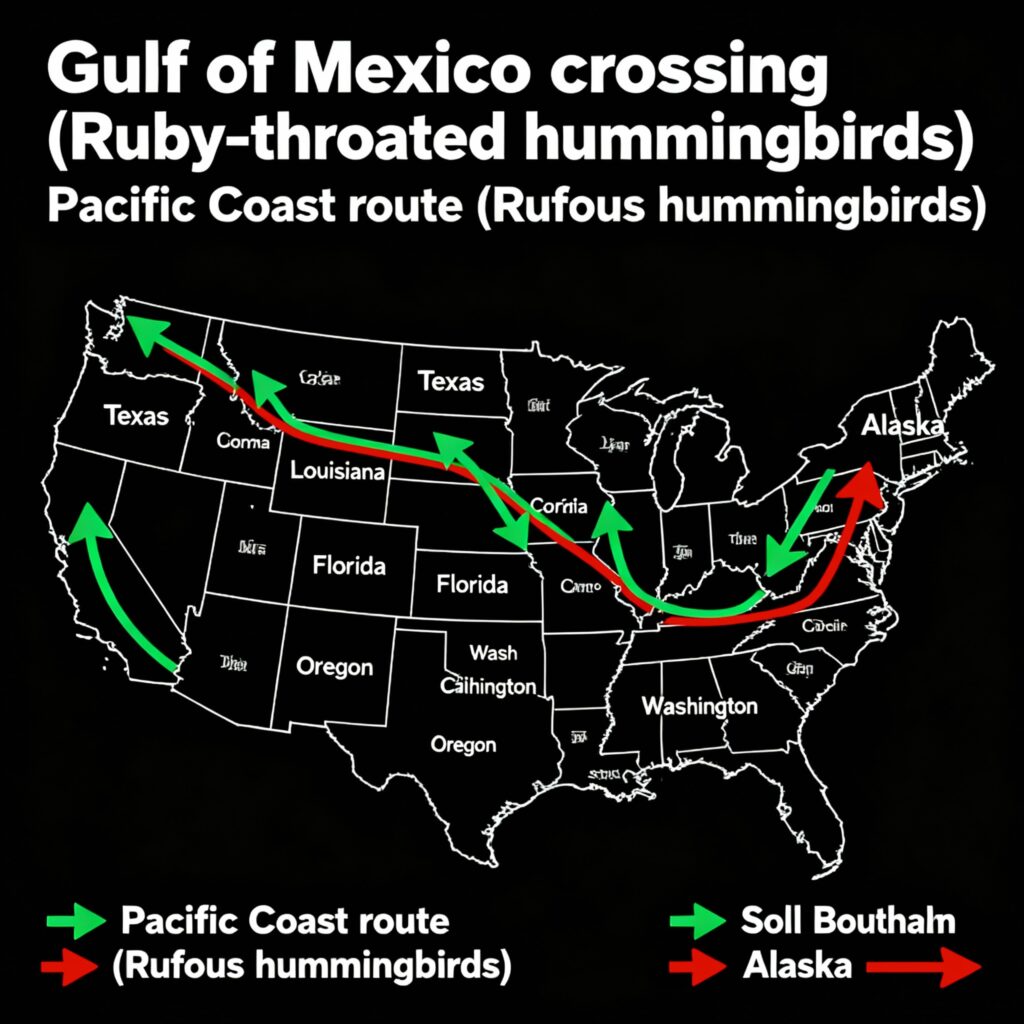
Understanding hummingbird migration is key to appreciating these energetic and iconic birds. In this article, we’ll explore when, where, and how hummingbirds migrate, focusing on the most common North American species. We’ll also address frequently asked questions to give you a complete picture.
Overview: Why Do Hummingbirds Migrate?
Hummingbirds migrate to find food and suitable breeding grounds. Most species nest in northern climates during spring and summer and migrate south to avoid winter’s cold and food scarcity. This remarkable journey requires careful timing and preparation, making migration a prime example of animal endurance and navigation.
When Do Hummingbirds Migrate?
Spring Migration (Northbound)
- Begins in late February or early March for the earliest species.
- Males generally migrate before females, arriving first to claim breeding territories.
- Most birds reach the southern U.S. (Texas, Louisiana, Florida) by mid to late March, continuing northward to final breeding grounds through April and May.
- Some species can take up to 6-8 weeks to complete the journey.
Fall Migration (Southbound)
- Begins as early as late July for some species, but most leave in August or September.
- Activity peaks in early September, especially for Ruby-throated hummingbirds at feeders in the eastern U.S.
- Migration continues through October, with the final birds crossing into southern wintering areas.
Annual Migration Timetable (Primary U.S. Species)
| Species | Northbound Migration | Southbound Migration |
|---|---|---|
| Ruby-throated | Late Feb – May | Aug – Oct |
| Rufous | Feb – May | Jul – Sep |
| Black-chinned | Mar – Apr | Aug – Sep |
| Broad-tailed | Mar – May | Aug – Sep |
| Calliope | Mar – May | Aug – Sep |
Hummingbird migration patterns are dictated by the need to find food and suitable breeding grounds, leading to extraordinary journeys across North America each spring and fall. Most hummingbirds spend winter in Central America or Mexico and migrate north to the southern United States as early as February, reaching further northern regions later in spring. Spring migration typically brings the first arrivals (usually males) to the Gulf Coast in late January to mid-March, with sightings spreading northward through April and May.
Spring Migration Patterns
Routes: Ruby-throated hummingbirds travel to the eastern U.S. and Canada, often crossing the Gulf of Mexico (a ~500 mile nonstop flight). Rufous hummingbirds follow a Pacific coast route up through California and into the Pacific Northwest and Alaska.
Timing: Spring migration generally spans from March to May for most species, with earlier departures for Rufous and later arrivals in northern states and Canada.
Behavior: Hummingbirds migrate solo, utilizing daylight for navigation and staying low to spot food sources along the way.
Energy: Before migrating, hummingbirds increase their body weight by up to 40% to fuel their journey, flying at speeds of 20-30 mph.
Fall Migration Patterns
Routes: Birds retrace their migration paths south, stopping to refuel along the Gulf Coast or following overland routes through the southern U.S. and Mexico.
Timing: Fall migration starts as early as July for some species, but most activity happens between August and October, peaking in September.
Behavior: Hummingbirds take advantage of abundant early morning and late afternoon food sources, often gathering in large numbers at feeders during peak months.
Migration Map Highlights
- Ruby-throated Hummingbird: Central America → Gulf Coast → Mississippi Valley → Eastern U.S./Canada in spring; reverse in fall.
Rufous Hummingbird: Mexico → California → Pacific Northwest/Alaska in spring; reverse in fall, even reaching Alaska, covering up to 4,000 miles.
Black-chinned/Broad-tailed/Calliope: Mexico and Central America → Rocky Mountains, Southwest, or Northwestern U.S./Canada, following valleys and foothills.
Navigational Strategies
Migration is driven by instinct, changes in daylight length, and food availability.
Unique Migration Facts
- Some hummingbirds, especially in California and along the upper Pacific Coast, may remain year-round without migrating.
Hummingbirds are experts at using tail winds to conserve energy and may travel up to 500 miles at a stretch, especially across open water like the Gulf of Mexico.
Sightings can be tracked via interactive migration maps and citizen reports, highlighting the real-time spread of hummingbirds each season.
Where Do Hummingbirds Migrate?
Spring Destinations
- Breeding grounds: Most North American species head to the U.S., Canada, and Alaska. Ruby-throated hummingbirds breed east of the Mississippi, Rufous and Calliope breed in the northwest and Alaska.
- Migration routes:
- Ruby-throated: Cross the Gulf of Mexico or travel up the Mississippi Valley.
- Rufous: Pacific Coast, through California, Oregon, and into Alaska.
- Watchpoints: Early morning and late afternoon are the best times to spot migrating hummingbirds.
Fall Destinations
- Wintering grounds: Central America (Mexico, Panama), some along the Gulf Coast from Texas to Florida, and southern Atlantic regions.
- Stopover sites: Gulf Coast, Mississippi Valley, Yucatán Peninsula, California coast.
How Do Hummingbirds Migrate?
Hummingbirds are solo flyers, using a mix of innate instincts and environmental cues:
- Navigation: Sun’s position, Earth’s magnetic field, and visual landmarks (such as rivers and coastlines)
- Fueling up: They double their weight before migration by feeding on nectar and insects.
- Flight facts:
- Many travel nonstop across large bodies of water (e.g., Ruby-throated hummingbirds cross the Gulf of Mexico, a 500+ mile flight).
- Distances range from 1,500 miles to over 4,000 miles depending on the species.
- Myths busted: Hummingbirds do not hitch rides on geese—each completes the trip solo.
Species Highlights
- Ruby-throated: Only eastern U.S. breeder; some cross the Gulf of Mexico, others use a land route through Mexico.
- Rufous: Extraordinary migration from Alaska to Mexico—one of the longest for body size (almost 4,000 miles).
Influences on Migration Timing
- Daylight length: Shorter fall days and longer spring days cue migration hormones.
- Weather and climate: Severe weather (storms, cold fronts) can cause earlier departures or longer stopovers.
- Food availability: Disappearance of nectar sources signals impending migration.
- Age and experience: Older birds and males often migrate first.
Hummingbird Migration Map
Here is a clear hummingbird migration map represented in table form without links, showing general migration timelines and patterns across key regions in the USA:
| Region | Spring Arrival Period | Fall Departure Period | Primary Species & Routes |
|---|---|---|---|
| Gulf South | January – March | August – October | Ruby-throated, Rufous; Entry/Exit via Gulf Coast and Mexico |
| Midwest | Early April – May | August – September | Ruby-throated; Moves north via Mississippi Valley |
| Northeast | Mid April – May | August – September | Ruby-throated; Movement from south to northeastern U.S. |
| West Coast | March – May | August – September | Rufous, Anna’s, Allen’s, Calliope; Coastal and inland routes |
| Southwest | March – April | August – September | Black-chinned, Rufous; Rocky Mountains corridor |
| Rockies | April – May | August – September | Rufous, Broad-tailed; Mountain valleys |
| Northern States | Late April – May | September | Ruby-throated, Rufous; Northernmost breeding grounds |
This table summarizes approximate migration timings and main species present in each region, reflecting how hummingbirds travel northwards to breed in spring and return south for the winter through fall.
Hummingbird migration in the USA varies by state due to geography, climate, and the arrival routes of key species like Ruby-throated, Rufous, and Black-chinned hummingbirds.
Southern States (Texas, Louisiana, Florida, etc.)
- Hummingbirds arrive as early as late January to March in states along the Gulf Coast, including Texas, Louisiana, Mississippi, Alabama, Georgia, and Florida.
These states act as major spring entry points, with males usually spotted first, often at feeders and early-blooming flowers.
Birds gather in these regions during fall (August–September) before continuing south or crossing the Gulf of Mexico for wintering in Mexico or Central America.
Midwest States (Illinois, Indiana, Ohio, Missouri, etc.)
States like Ohio, Illinois, and Missouri begin seeing Ruby-throated hummingbirds during the second half of April, peaking into May.
Sightings increase as flowers bloom and daylight grows, with feeders attracting both breeding and migrating birds.
Northeast and Mid-Atlantic States (New York, Pennsylvania, New Jersey, Massachusetts, etc.)
- Hummingbirds arrive in the Northeast in mid to late April, with sightings in states like New York, Pennsylvania, and New Jersey.
- By May, they reach as far north as Maine.
Ruby-throated hummingbirds are the predominant species in this region.
West Coast States (California, Oregon, Washington)
- Rufous, Allen’s, Anna’s, and Calliope hummingbirds migrate along the Pacific Coast, appearing in California and Oregon as early as spring (March–April).
Rufous hummingbirds are known for their extensive journey, reaching Washington and Alaska by May.
Anna’s hummingbirds are often resident year-round in coastal areas, but migration peaks are still observable in spring.
Rocky Mountains and Southwest (Arizona, New Mexico, Colorado, etc.)
Rufous and Black-chinned hummingbirds utilize the Rocky Mountain corridor for both spring and fall migration.
Migration patterns can vary by altitude and location, with peak activity in river valleys and mountain meadows.
Northern States (Minnesota, Wisconsin, Michigan, Maine)
- Hummingbirds reach the northernmost states—Minnesota, Wisconsin, Michigan, and Maine—by late April or early May.
Final arrivals occur as spring progresses and temperatures rise, marking the end of the northbound migration.

Hummingbird Migration (FAQs)
Q: When do hummingbirds usually leave for migration?
A: Most start southbound migration between late July and mid September, with peak movement in August and September, and final departures by late October.
Q: Do all hummingbirds migrate?
A: Not all. Some species, especially those in Central America, stay year-round. Most North American species—especially Ruby-throated, Rufous, and Black-chinned—migrate seasonally.
Q: How far do hummingbirds migrate?
A: Typical distances range from 1,500 to 4,000 miles; Rufous hummingbirds hold the record, traveling nearly 4,000 miles from Alaska to Mexico.
Q: How do hummingbirds find their way?
A: Instinct, sun angle, magnetic fields, and familiar landmarks guide their amazing journeys.
Q: Should I leave up my hummingbird feeder in fall?
A: Yes! Keeping feeders up does not interfere with migration and can help birds refill energy for the journey. Remove once no birds are observed for a couple weeks after peak migration.
Q: Why do males migrate before females?
A: Males arrive early to claim the best breeding territories, then court females who arrive later.
Q: Is it true that hummingbirds ride on other birds to migrate?
A: No, this is a myth. Hummingbirds fly solo, relying on their own strength and navigation abilities.
Q: How long does migration take?
A: Depending on route and stops, travel can take 2–8 weeks for a complete migration.
Q: Can severe weather stop migration?
A: Yes, storms, cold, or lack of food may cause delays or force birds to seek shelter temporarily, but migration is primarily driven by daylight changes.
Quick Review & Key Points
- Timing: Migration happens twice each year—north in spring (Feb–May), south in late summer/fall (Aug–Oct).
- Where: Routes cover all of North America, with most birds wintering in Central America, some in the U.S. Gulf Coast.
- How: Hummingbirds migrate alone, using daylight cues, innate navigation, and fueling up on nectar.
- Feeding: Keeping feeders up during fall migration is helpful—not harmful.
Key Takeaways
- Hummingbirds migrate solo, not in flocks, with young birds navigating their first journey independently.
Migration distance ranges from 1,500 to over 4,000 miles, depending on species.
Most North American hummingbirds migrate twice annually—north in spring and south in fall—while some populations remain year-round in milder climates.
Hummingbird migration patterns reflect a blend of endurance, instinct, and adaptation, making these birds remarkable travelers in the avian world.
Summary
Hummingbird migration is a breathtaking display of endurance, timing, and natural navigation. Each spring and fall, millions of hummingbirds—especially Ruby-throated and Rufous—move thousands of miles between breeding and wintering grounds. Knowing when, where, and how hummingbirds migrate improves our ability to help, watch, and protect these exquisite birds year after year.
Your Turn: Observation Tips
- Watch feeders during peak migration times: early mornings in spring and fall.
- Track local sightings using online migration maps for your region.
- Plant nectar-rich flowers and keep feeders clean and full to support migrating hummingbirds.
Citations
- https://transylvania.ces.ncsu.edu/follow-the-spring-return-of-the-hummingbirds/
- https://www.hummingbirdcentral.com/hummingbird-migration.htm
- https://www.audubon.org/magazine/where-do-hummingbirds-go-winter-do-they-migrate
- https://journeynorth.org/tm/humm/migration_route.html
- https://www.bhg.com/help-hummingbirds-migration-season-11811007
- https://empressofdirt.net/hummingbird-migration-map/
- https://bri.sulross.edu/conservation-biology/hummingbird-migration/

Hi, There and Welcome to BirdsNews.com, is here to help you learn and care about pet birds. and this blog is a journal of everything I’ve learned.
